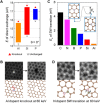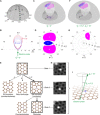Engineering single-atom dynamics with electron irradiation
- PMID: 31114798
- PMCID: PMC6524980
- DOI: 10.1126/sciadv.aav2252
Engineering single-atom dynamics with electron irradiation
Abstract
Atomic engineering is envisioned to involve selectively inducing the desired dynamics of single atoms and combining these steps for larger-scale assemblies. Here, we focus on the first part by surveying the single-step dynamics of graphene dopants, primarily phosphorus, caused by electron irradiation both in experiment and simulation, and develop a theory for describing the probabilities of competing configurational outcomes depending on the postcollision momentum vector of the primary knock-on atom. The predicted branching ratio of configurational transformations agrees well with our atomically resolved experiments. This suggests a way for biasing the dynamics toward desired outcomes, paving the road for designing and further upscaling atomic engineering using electron irradiation.
Figures




References
-
- Ishikawa R., Mishra R., Lupini A. R., Findlay S. D., Taniguchi T., Pantelides S. T., Pennycook S. J., Direct observation of dopant atom diffusion in a bulk semiconductor crystal enhanced by a large size mismatch. Phys. Rev. Lett. 113, 155501 (2014). - PubMed
-
- Susi T., Kotakoski J., Arenal R., Kurasch S., Jiang H., Skakalova V., Stephan O., Krasheninnikov A. V., Kauppinen E. I., Kaiser U., Meyer J. C., Atomistic description of electron beam damage in nitrogen-doped graphene and single-walled carbon nanotubes. ACS Nano 6, 8837–8846 (2012). - PubMed
-
- Lee J., Zhou W., Pennycook S. J., Idrobo J.-C., Pantelides S. T., Direct visualization of reversible dynamics in a Si6 cluster embedded in a graphene pore. Nat. Commun. 4, 1650 (2013). - PubMed
-
- Susi T., Kepaptsoglou D., Lin Y.-C., Ramasse Q. M., Meyer J. C., Suenaga K., Kotakoski J., Towards atomically precise manipulation of 2D nanostructures in the electron microscope. 2D Mater. 4, 42004 (2017).
Grants and funding
LinkOut - more resources
Full Text Sources
Other Literature Sources

